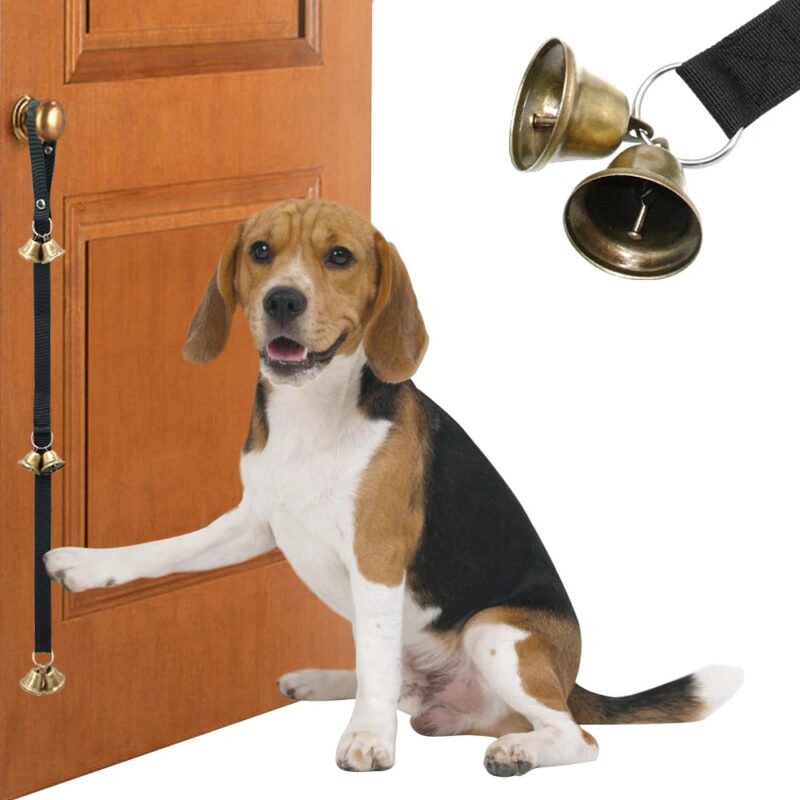Bell Training, potty training, Ring a Bell to Go Outside
How to Bell Train Your Dog for Potty Time Only

How to Bell Train Your Dog for Potty Time Only: A Comprehensive Guide for Effective Communication By Will Bangura, M.S., CBCC-KA, CPDT-KA, (Dog Behaviorist,) Certified Behavior Consultant. Do you want to potty train your dog quickly and efficiently? Bell training your dog is a great way to do just that. It’s a simple and effective way to communicate with your pup, and it’s been used with great success by dog owners all around the world. In this blog post, we’ll dive into the world of bell training. We’ll discuss what it is, the benefits of it, the importance of timing, how to establish the right environment for it, how to choose the right bell and treat, and the steps you need to take to start bell training. Plus, we’ll provide some tips and troubleshooting advice to ensure you get the most out of your bell training experience. Ready to learn more? Let’s get started!
What is Bell Training?
Bell training is a method of teaching your dog to ring a bell when they need to go outside to do their business. It’s a great way to communicate with your pup and can be used for both potty time and playtime. When you’re bell training, you’ll start by attaching a bell to the door handle that your pup uses to go outside. Whenever your pup needs to go outside, they’ll ring the bell and you’ll open the door for them. Over time, your pup will learn to associate the ringing of the bell with going outside to do their business. The goal of bell training is to help your pup learn to communicate their needs without having to bark or whine. This can be incredibly helpful if you live in an apartment or have neighbors close by who don’t appreciate the sound of a barking dog.Benefits of Bell Training.
There are several benefits to bell training your pup. The most obvious one is that it can help you potty train your pup faster and more effectively. It’s a great way to teach your pup to communicate their needs without having to use vocal cues like barking or whining. Bell training is also a great way to bond with your pup. Whenever your pup rings the bell, you’ll be there to reward them for their effort. This reward will make them more likely to continue ringing the bell in the future. Bell training is also a great way to help your pup learn to self-regulate. By teaching them to ring the bell when they need to go outside, you’re helping them learn to control their own behavior. This can be incredibly helpful in the long run, as it can help your pup become a more well-behaved member of the family.The Importance of Proper Timing.
Timing is incredibly important when it comes to bell training. If you’re too slow in responding to your pup’s bell ringing, they may give up and stop ringing it altogether. On the other hand, if you’re too quick to respond, your pup may come to expect you to open the door immediately whenever they ring the bell. The key is to respond to your pup’s bell ringing at the right time. This means you should wait a few seconds after your pup rings the bell before you open the door for them. This will help your pup learn that ringing the bell will get them what they want, but it won’t be immediate. It’s also important to be consistent with your timing. If you respond to your pup’s bell ringing at different times, they may become confused and frustrated. To ensure your pup’s success, make sure you respond at the same time each and every time.Establishing the Right Environment for Bell Training.
It’s important to create the right environment for your pup when you’re bell training. This means you should ensure that your pup is comfortable and relaxed before you begin. You should also make sure that there are no distractions in the environment such as other people or animals. You should also make sure that your pup has enough space to move around. If your pup is cramped in a small area, they may become frustrated and may not be as willing to engage in the bell training process. Finally, it’s important to ensure that your pup has access to the bell at all times. If your pup can’t find the bell, they won’t be able to ring it when they need to go outside.Choosing the Right Bell and Treat.
When it comes to bell training, it’s important to choose the right bell and treat. The bell should be lightweight and easy for your pup to ring. A small bell with a thin handle is usually best. As for the treat, it should be something that your pup loves. This could be a piece of their regular food, a treat specifically designed for bell training, or even a toy they can play with outside. It’s also important to make sure that the bell and treat are easily accessible. If your pup has to search for them, they may become frustrated and give up.Steps to Start Bell Training.
Once you’ve established the right environment and have chosen the right bell and treat, it’s time to start bell training. Here are the steps to get started:- Begin by placing the bell on the door handle that your pup uses to go outside.
- Place the treat next to the bell.
- Whenever you take your pup outside, make sure to praise them when they ring the bell.
- Give them the treat immediately after they ring the bell.
- Repeat this process several times until your pup starts to associate ringing the bell with going outside.
- After a few days, start to withhold the treat until your pup rings the bell.
- Once your pup is ringing the bell consistently, you can start to reduce the amount of praise and treats you give.
Tips for Successful Bell Training.
When it comes to bell training, it’s important to be patient and consistent. Here are some tips to ensure you get the most out of your bell training experience:- Make sure to give your pup plenty of praise and treats when they ring the bell. This will help them associate ringing the bell with positive reinforcement.
- Don’t rush the process. Bell training takes time and patience.
- Don’t be too quick to respond to your pup’s bell ringing. Make sure to wait a few seconds before you open the door.
- Don’t give up. Even if your pup isn’t getting it right away, keep practicing and they’ll eventually get it.
- Make sure to keep the bell and treat easily accessible for your pup.
- Be consistent with your timing. Respond to your pup’s bell ringing at the same time each and every time.
Troubleshooting Common Bell Training Issues.
Even with the best tips, there may be some issues that arise during the bell training process. Here are some troubleshooting tips to help you out:- If your pup isn’t ringing the bell, make sure that the bell and treat are easily accessible.
- If your pup is ringing the bell too often, make sure to respond only when they really need to go outside.
- If your pup isn’t responding to the treat, try using a different treat or a toy they can play with outside.
- If your pup is getting frustrated, take a break and try again later.
- If your pup isn’t responding to the bell, make sure you’re praising them when they ring it.
Advanced Bell Training Techniques: Bell Train Your Dog for Potty Time Only.
Once your pup has mastered the basics of bell training, you can move on to more advanced techniques. Here are some ideas to get you started:- Try using multiple bells. This can help your pup differentiate between different activities such as potty time and playtime.
- Try using a timer. This can help your pup learn to self-regulate and know when it’s time to go outside.
- Try using a clicker. This can help your pup learn to associate the sound of the clicker with going outside.
- Try using a leash. This can help your pup learn to stay by your side when they’re outside.
References.
- American Kennel Club (AKC) article on bell training: https://www.akc.org/expert-advice/training/bell-training-for-dogs/
- The Spruce Pets’ guide to bell training: https://www.thesprucepets.com/train-your-dog-to-ring-a-bell-to-go-outside-4165372
- PetMD’s article on using bells for potty training: https://www.petmd.com/dog/training/evr_dg_how-to-potty-train-your-dog-using-bells
- Whole Dog Journal’s guide to bell training: https://www.whole-dog-journal.com/training/train-your-dog-to-ring-a-bell/
- Dog Time’s article on bell training: https://dogtime.com/dog-health/general/54853-bell-training-dog-take-10-steps
- AKC’s video on how to bell train your dog: https://www.akc.org/expert-advice/training/how-to-bell-train-your-dog-video/
- YouTube video by Zak George on bell training: https://www.youtube.com/watch?v=G6xRaASMDv0
- YouTube video by The Dog Training Secret on bell training: https://www.youtube.com/watch?v=In1l6NbHzcM
- YouTube video by Kikopup on bell training: https://www.youtube.com/watch?v=co5m-LDgJfI



